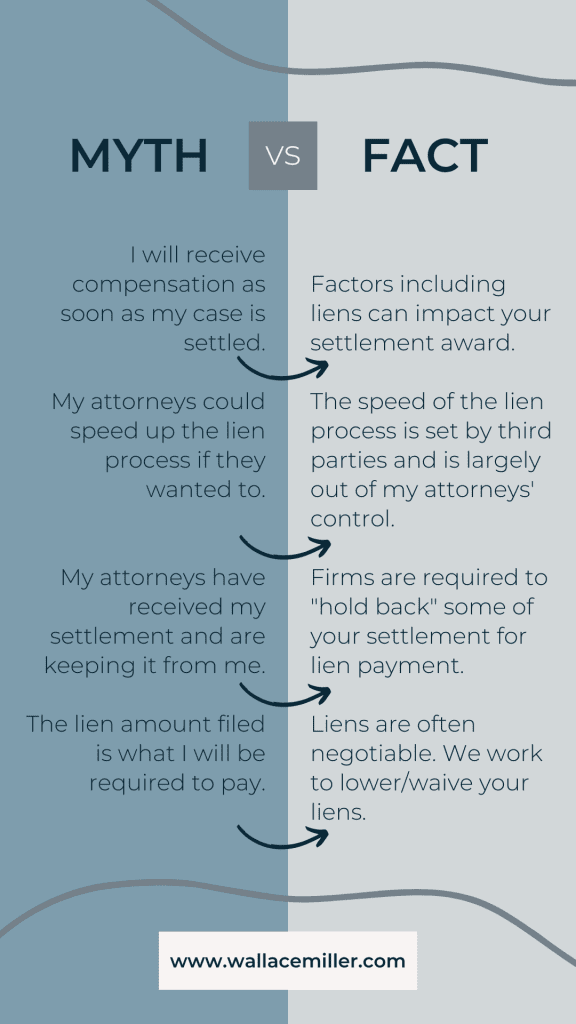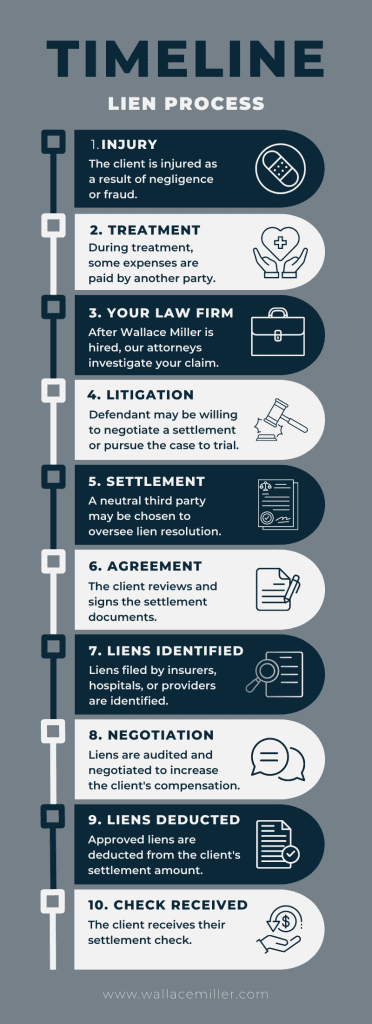

The settlement process in a mass tort or personal injury case can be complicated. Even after the defendant is ordered to pay damages, several factors can still affect your compensation.
These factors can include medical liens, bankruptcies, and estate issues. At Wallace Miller, we’re committed to making this process as transparent, efficient, and straightforward as possible. In this article, we’ll break down subrogation and medical liens—what they are, how they work, and what they mean for your case.
A lien is the legal right of a creditor to be repaid for a debt via access to the property or assets of the debtor.
There are many different types of liens, including real estate, judgment, and tax liens. For mass tort and personal injury claims, Wallace Miller works with medical lien agreements related to your lawsuit.
In a personal injury lawsuit where you have been compensated for an injury—for example, if your insurance company paid for some of your medical bills through your insurance plan—the party who initially covered your medical expenses may be legally entitled to recoup their cost from the settlement provided. This is referred to as a medical lien or a claim on your settlement award from an insurance company requesting payment for services rendered by your medical institution.
Your insurance company may have paid for medical treatment, surgery, follow-up hospital care, pain medication, or other medical expenses. If these expenses are linked to your personal injury claim, the insurance company is entitled to a percentage of your compensation.
The more of your treatment that your insurance plan covers, the more likely it is that you will have a lien for a substantial amount. Your insurance provider is more likely to file a lien if they have paid for more of your medical care.

Photograph by Pixabay.
In a personal injury claim, the term lien refers to a subrogation claim—which means that for most lawsuits dealing with healthcare providers, the two terms can be used interchangeably.
Technically speaking, subrogation is a legal technique in which one party takes on the role of another party. For example, an insurance company can take on the role of the plaintiff or injured party to have a right to the settlement money provided by the defendant for medical services.
Because a lien is the right of a creditor, like an insurance company, to receive money from someone’s property or assets to settle a debt, a subrogation lien or subrogation interest is simply the right of a third party to be reimbursed via a personal injury claim or mass tort settlement for medical expenses incurred by the client.
In establishing and overseeing legal procedures, clarifying the distinctions between subrogations and liens is important. However, for the purposes of personal injury and mass tort cases, it is usually clearer and more efficient to use the term lien to refer to the full subrogation interest negotiation.

Medical liens in personal injury and mass tort cases are filed by medical insurance companies and healthcare providers. Medicare and Medicaid most often bring them, although private insurance companies can also submit a claim. Under federal and state regulations, liens filed by Medicare and Medicaid must be resolved first, followed by any liens from private insurance companies.
Insurance companies are legally entitled to assert a lien on a settlement to compensate for medical costs. The exact stipulations of these liens will depend on the contract established by the private insurance company.

The lien resolution process is complicated and can take months or years. Institutions like Medicare require communication via hard copy, and negotiations often go back and forth several times. Private insurance companies often conduct lien resolution more quickly, but under federal and state regulations, claims from public health insurance programs like Medicare and Medicaid must be resolved first.
As a result of regulatory rollbacks and the backlog in processing caused by the COVID-19 pandemic, the process timeline has increased significantly in the last several years. Before 2020, the average resolution time for the lien process in mass tort cases was four to six months. As a result of recent changes, mass tort lien negotiation typically takes a year or longer to resolve. The process for single-event personal injury cases can proceed more quickly, with lien negotiations typically taking between a few weeks and a few months.
This time-consuming negotiation can be frustrating as a plaintiff—especially since the settlement money seems to have already been awarded and is now being withheld by attorneys and insurance providers. Although this is not the case, it’s upsetting nonetheless. Unfortunately, lien agreement resolution is mandated by law for programs like Medicare and Medicaid and is often written into private insurance policies. Insurance companies also control negotiation deadlines, so your attorneys have little control over how long it takes.
If you are awarded a settlement in a personal injury claim, your lawyer will work with you to update you on the status of your lien resolution. Lien resolution does not impact attorneys’ fees, and so attorney negotiations in this process occur solely for the client’s benefit. The team at Wallace Miller is committed to providing you with compensation as quickly and efficiently as possible and maximizing your total compensation amount. We will do everything we can to ensure your case progresses in the system.
It can feel unfair that insurance providers can “double dip” by charging premiums for health insurance and then filing liens on future compensation. Some states have begun to pass legislation to limit how insurance companies can file liens or at least streamline the negotiation so that plaintiffs do not wait years to receive their settlement money. However, because liens are permitted by federal law, all law firms must go through the resolution process to make sure no liens are owed.
The best thing to do if you are frustrated by the lien timeline is to contact your congressperson or elected representative. They can advocate for the setup of the lien system to be revisited to move more quickly and fairly for plaintiffs.
The resolution begins after the settlement agreement has been finalized. Depending on the litigation, the court or settlement agreement may designate a neutral third party to oversee the process.
This lien resolution company will identify if any liens have been filed and determine their amounts. After an auditing process, the company will negotiate with the insurance companies to reduce the lien amount as much as possible.
After the settlement proceeds are distributed, they will work with your law firm to determine a payment plan for the agreed-upon lien amount.
Medical liens are often negotiable, and your personal injury lawyer at Wallace Miller and the lien resolution company will conduct an in-depth audit of the liens asserted on your case and challenge any they believe are not valid.
These may include liens that apply to medical care outside of the time frame of the case, care with incorrect or irrelevant billing codes, and services unrelated to the claim in question. Your representatives will negotiate to waive as many liens as possible and reduce those that can’t be waived to maximize the compensation you receive.
Some insurance companies will accept waived liens, while others won’t—every personal injury case is unique and must be conducted individually.
The law requires that part of your total settlement award be “held back” or reserved to pay any liens that have been filed. This money, usually held by the defendant, is unavailable to anyone, including your law firm, until the lien resolution has concluded. During the resolution process, your law firm will conduct research to find out if any liens have been filed.
The lien resolution process can take months or even years. To get some of your settlement money to you as soon as possible, Wallace Miller and other law firms will often pay your settlement in two installments. In these situations, the first check does not include the money held back to pay any potential liens. Then, after the resolution process has concluded, any liens will be subtracted from the holdback, and the remaining amount will be sent to the plaintiff. If it’s proven that there are no liens on the settlement, the full amount held back will be paid to the plaintiff.

Photograph by Pixabay.
Many plaintiffs are familiar with class actions, in which it usually only takes a few months to receive a settlement after a plaintiff provides their payout information. This is possible because, in class action cases, the suit is filed by a “class” of people under one or a few representatives.
In mass tort litigation, on the other hand, each plaintiff brings an individual case against the defendant(s). These may then be grouped together into multidistrict litigations to go through litigation more efficiently, but they remain individual claims.
Money is often distributed to clients via a global settlement for litigations like these. Each plaintiff in a mass tort litigation receives a copy of the settlement documents, including the offer amount and a release. These must be signed and returned to accept the compensation offer.
A certain threshold of returned settlement documents must be reached before defendants issue funding. This threshold is typically between 80 to 95% of releases. This threshold applies to cases at Wallace Miller and to all cases represented by law firms participating in multidistrict litigation nationwide.
The defendants will not start reviewing claims until that threshold is reached. In turn, lien negotiations can’t begin until this stage is completed. This means that mass tort settlements often have a significant wait time even before the lien negotiation begins.

Left to right: Nicholas P. Kelly, Edward A. Wallace, Molly Condon Wells, Mark R. Miller, Jessica Wieczorkiewicz, Timothy E. Jackson.
We know that the lien process can be confusing and frustrating, so our team is with you every step of the way. Wallace Miller’s trained settlement coordinators are available to answer your questions and walk you through lien resolution as your case is resolved.
Questions about your settlement? Call Wallace Miller at (312) 261-6193 or fill out our online questionnaire to discuss your case today.
Something of value owned by an individual or organization. This includes physical assets, such as property, or intangible assets, like intellectual property.
The organization or individual to whom money is owed.
The party being sued in criminal or civil court. In a civil case, the defendant is the party against whom the suit is filed
A company that issues insurance contracts to provide financial protection against potential future hazards.
The legal right of a creditor to be repaid for a debt via access to the property or assets of the debtor. A medical lien is a claim on your settlement award from an insurance agency or healthcare organization requesting payment for services they have provided.
An amount held back from your settlement to satisfy any potential liens.
The court or settlement agreement designated a neutral third party to oversee the lien resolution process. The lien resolution company will identify, audit, and negotiate any liens filed.
A legal dispute is filed when one individual (the plaintiff) suffers harm and claims another individual or organization (the defendant) may be legally responsible for paying damages.
Personal injury lawsuits are civil cases. Examples may include an individual suing for broken bones as a result of a collision with a drunk driver; compensation for cancer caused by a chemical exposure at a factory; or harm suffered due to a dangerous product on the market.
The suing party in a criminal or civil case. In a civil case, the plaintiff is the person filing the lawsuit. Plaintiffs bring lawsuits in civil court because they believe they have been harmed by the defendant physically, financially, or otherwise.
The legally binding agreement to resolve the dispute between the plaintiff and defendant in litigation. The release must be signed for the plaintiff to obtain their settlement.
An agreement is reached by the plaintiff and defendant before a trial, often including financial compensation on the defendant’s part. Settlements differ from verdicts, which are the official decisions a judge or jury makes after trial proceedings.
When a defendant negotiates a settlement with multiple plaintiffs, they may opt to undergo a course of action that applies to all individual claims. This is called a global settlement.
A legal technique in which one party takes on the role and obligations of another party. For example, an insurance company can take on the role of a plaintiff in a personal injury case to have a right to the settlement award paid by the defendant for medical expenses.
Related posts